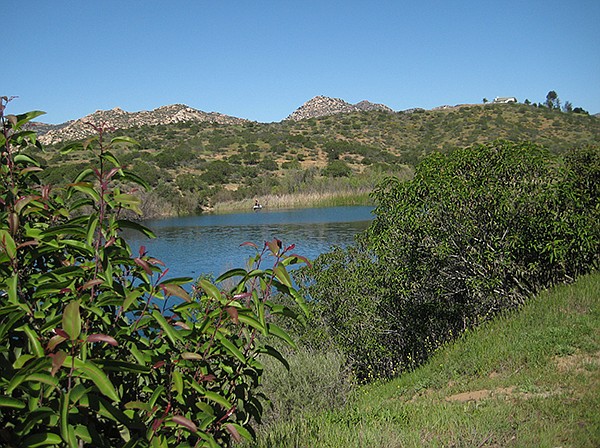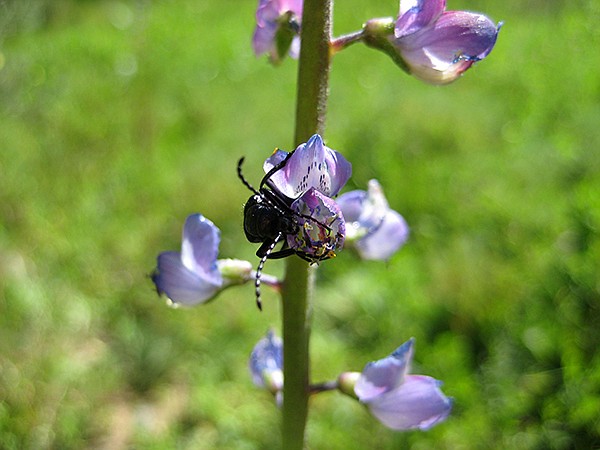 Facebook
Facebook
 X
X
 Instagram
Instagram
 TikTok
TikTok
 Youtube
Youtube




Lake Jennings is a manmade 9800-acre-foot capacity reservoir owned by the Helix Water District. In 1962 the Helix Irrigation District built Chet Harritt Dam, which forms the reservoir, storing water that is treated and used by more than 260,000 people in the San Diego region today. The lake is named for Bill Jennings, who served on the California Water Commission and was legal counsel for the district. Harritt was the district’s first manager. The water district operates the recreational facilities at the lake, which include fishing, camping, picnicking, boating, and hiking activities. The lake is open for recreational day-use Friday through Sunday and daily for registered campers. The campground is open year-round. Call for seasonal hours for day-use, which includes some night hours during summer.
The hike begins from any starting point you choose. A nice stroll around the lake is a great way to watch for waterfowl, starting from the bait shop. This 5.5-mile route includes the paved road and a dirt trail. Another starting point is to drive to the end parking area by Eagle Point and take the dirt road northwest about 1.5 miles, eventually going through the camping area. Halfway along this trail overlooking Half Moon Cove is a low ridge and saddle to the north. Climb the ridge for a view of the lake and El Cajon Mountain in the distance. From the camping area, continue on the road back down to the bait shop and around the rest of the lake to where you parked or turn around on the dirt trail to complete a 3-mile out-and-back hike.
The area around the lake was once part of the 48,800-acre Mexican land grant known as Rancho El Cajon. The terrain that surrounds the lake is a mix of coastal sage scrub, native chaparral, and riparian plants. Laurel sumac, California sagebrush, and arroyo willow can all be seen in abundance alongside a variety of wildflowers. Lupine, San Diego sunflower, phacelia, wild hyacinth, and wild cucumber are just a few of the flowers that grace the area. Prickly pear cactus is on the hillsides.
Keep an eye out for any birds that can be seen along the trail and around the lake, including white pelicans, turkey vultures, and bald eagles. Also present are a number of local and migratory shorebirds. Look for butterflies, including the orange-tipped butterfly and painted ladies as well as various lizards and signs of small mammals, such as raccoons and woodrats.
The trail offers no real shade, so it is best to hike in the early mornings before the heat of the day sets in or to keep close to the shore where there are more trees. You can enjoy a picnic while taking in the splendid scenery.
If there is time, stop by the water-treatment facility on Lake Jennings Park Road, south of the campground. A xeriscape garden is found there, with plants that can best survive in a dry climate with little water. Across from the garden is a display of part of the old redwood flume that once carried water from the Cuyamaca Mountains to San Diego. The 25-mile-long flume opened in 1889 and was officially retired in November 1937 after El Capitan Dam and Reservoir was completed in 1935.
Distance from downtown San Diego: About 23 miles. Allow 25 minutes driving time (Lakeside). From I-8 East, exit onto Lake Jennings Park Road (Exit 23) and then turn north and follow the signs to Lake Jennings recreation area picnic/fishing entrance via Harritt Road. There is a day-use fee payable at the bait-and-tackle shop.
Hiking length: 5.5 miles for a loop with different options of varying length, including an out-and-back.
Difficulty: Easy. Mostly level with a slight elevation gain on the trail up to the campground from the bait shop. Facilities. Paved portion is handicapped accessible.





Lake Jennings is a manmade 9800-acre-foot capacity reservoir owned by the Helix Water District. In 1962 the Helix Irrigation District built Chet Harritt Dam, which forms the reservoir, storing water that is treated and used by more than 260,000 people in the San Diego region today. The lake is named for Bill Jennings, who served on the California Water Commission and was legal counsel for the district. Harritt was the district’s first manager. The water district operates the recreational facilities at the lake, which include fishing, camping, picnicking, boating, and hiking activities. The lake is open for recreational day-use Friday through Sunday and daily for registered campers. The campground is open year-round. Call for seasonal hours for day-use, which includes some night hours during summer.
The hike begins from any starting point you choose. A nice stroll around the lake is a great way to watch for waterfowl, starting from the bait shop. This 5.5-mile route includes the paved road and a dirt trail. Another starting point is to drive to the end parking area by Eagle Point and take the dirt road northwest about 1.5 miles, eventually going through the camping area. Halfway along this trail overlooking Half Moon Cove is a low ridge and saddle to the north. Climb the ridge for a view of the lake and El Cajon Mountain in the distance. From the camping area, continue on the road back down to the bait shop and around the rest of the lake to where you parked or turn around on the dirt trail to complete a 3-mile out-and-back hike.
The area around the lake was once part of the 48,800-acre Mexican land grant known as Rancho El Cajon. The terrain that surrounds the lake is a mix of coastal sage scrub, native chaparral, and riparian plants. Laurel sumac, California sagebrush, and arroyo willow can all be seen in abundance alongside a variety of wildflowers. Lupine, San Diego sunflower, phacelia, wild hyacinth, and wild cucumber are just a few of the flowers that grace the area. Prickly pear cactus is on the hillsides.
Keep an eye out for any birds that can be seen along the trail and around the lake, including white pelicans, turkey vultures, and bald eagles. Also present are a number of local and migratory shorebirds. Look for butterflies, including the orange-tipped butterfly and painted ladies as well as various lizards and signs of small mammals, such as raccoons and woodrats.
The trail offers no real shade, so it is best to hike in the early mornings before the heat of the day sets in or to keep close to the shore where there are more trees. You can enjoy a picnic while taking in the splendid scenery.
If there is time, stop by the water-treatment facility on Lake Jennings Park Road, south of the campground. A xeriscape garden is found there, with plants that can best survive in a dry climate with little water. Across from the garden is a display of part of the old redwood flume that once carried water from the Cuyamaca Mountains to San Diego. The 25-mile-long flume opened in 1889 and was officially retired in November 1937 after El Capitan Dam and Reservoir was completed in 1935.
Distance from downtown San Diego: About 23 miles. Allow 25 minutes driving time (Lakeside). From I-8 East, exit onto Lake Jennings Park Road (Exit 23) and then turn north and follow the signs to Lake Jennings recreation area picnic/fishing entrance via Harritt Road. There is a day-use fee payable at the bait-and-tackle shop.
Hiking length: 5.5 miles for a loop with different options of varying length, including an out-and-back.
Difficulty: Easy. Mostly level with a slight elevation gain on the trail up to the campground from the bait shop. Facilities. Paved portion is handicapped accessible.